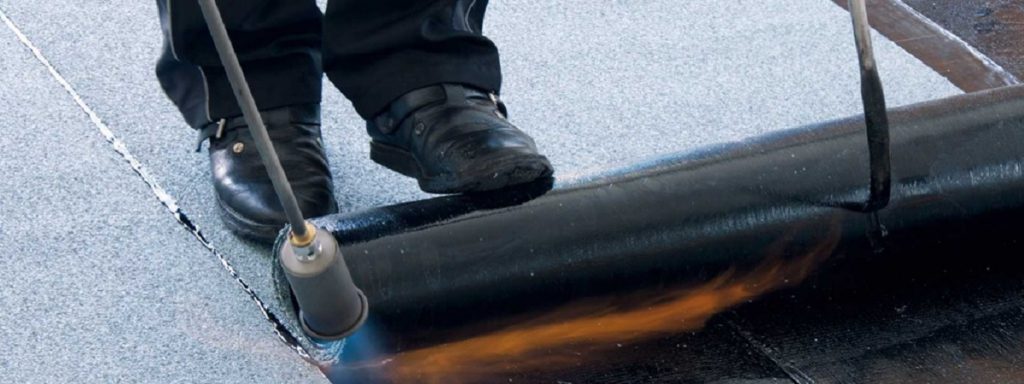
APP and SBS Membranes
By adding other materials to the bitumen, manufacturers can create a longer-lasting, more durable product – giving it either plastic or rubber properties. Modifying bitumen gives it the ability to withstand a wide temperature range, and superior weather proofing.
For any roofing projects in cold weather environments, Elastoflex SA P Polar Base and Cap Sheets are an ideal membrane choice. These self-adhered SBS membranes feature high-performance fiberglass reinforcement to create a stable and insulated roofing system.
Browse our extensive range of high-quality APP membranes and SBS membranes, and for more tips on commercial roofing, be sure to sign up for our newsletter below.
APP Membranes: APP are bitumen composed of plastomer. This means that the bitumen have been processed with an elastic plastic, which makes them flexible at certain ambient temperatures. This means that APP bitumen roof coverings are more resistant to the sun and UV radiation than SBS bitumen roof coverings. This ease of melting makes APP bitumen popular on smaller roofs such as residential properties and commercial flat roofs. APP-modified bitumen is a plastic bitumen blend, which is modified using plastic in the form of atactic polypropylene (APP). As installers begin to torch-apply APP, this type of plastic begins to melt at a point of 300F, where it melts into a liquid wax like substance which acts as an almost free-flowing liquid which can then be mopped across a surface. APP has a high temperature tolerance when heating, so is more user-friendly for installers.
SBS Membranes: SBS are bitumen composed of elastomer. This material is a plastic that already has the elastic properties. The great advantage of SBS bitumen roofing is that it can properly absorb the working of underlying structures ,because it can stretch. The big disadvantage is that it is not well protected against the exposure of a lot of UV radiation. SBS systems can also be installed with cold adhesive on projects where open flames are not permitted. Because of the rubber used in its construction, SBS-bitumen is more flexible when compared to the plastic used in APP. This flexibility means it has recovery properties, making it capable of withstanding stresses created by wind, temperature fluctuation and expansion and contraction.
How to Installing APP and SBS Membranes?
Heat-welding involves heating the membrane with a hot air welding gun until the compound starts to melt and then adhering it to the roof’s surface. APP and SBS membranes have slightly different reactions to this process. APP membranes melt at higher temperatures, giving them a more fluid consistency and making them easier to work with. SBS membranes have a lower melting point but become stickier when exposed to sufficient temperatures.
SBS membranes can be applied by heat-welding, hot-mop, cold-process adhesive, self-adhering membranes and can also be mechanically attached. APP membranes can be heat-welded or ADESO self-adhered.
These different characteristics make APP, and SBS membranes have different advantages regarding how they are used. APP membranes are used more often on smaller roofing areas because they flow more easily. SBS membranes can tolerate much lower temperatures, making them ideal for cold-weather areas. They also take less time to install and last longer.
Self-adhered membranes can be installed quickly and easily without the need for unsafe techniques such as torch application. Instead, sheets of self-adhered membranes have adhesive bottom layers that can be fixed to the roof in overlapping layers.
Use is of SBS Bitumen on roofers
Ultimately, deciding on the actual type of modified bitumen depends on your project. To reduce timescales or to avoid the use of open flames, SBS-Modified Bitumen gives roofers the versatility needed whilst retaining the same level of hardwearing weather-proofing. However, because APP bitumen is more forgiving to install under hot-melt conditions, it may be preferable. All SOPREMA bitumen systems are offered with industry-leading warranties, and support for all products is available.
Benefits and Application of APP and SBS
bituminous waterproofing membranes come with an impressive array of advantages, such as excellent strength, resistance and adherence; minimising the chance of leaks. Moreover, we owe our leading position in bitumen membranes to our membranes’ longevity and the fact that they are unaffected by building movement. The waterproofing material absorbs stresses and can stretch without affecting underlying layers like insulation. It even remains supple under extreme temperatures of up to -30°, making it exceptionally easy to apply. bituminous membranes do not contain any toxic substances and are completely pH neutral. This makes the material very suitable for rainwater recovery with retention roofs.
Through new technology and countless finishes, our bituminous membranes complement all forms of architecture, constituting an excellent choice for both new build and refurbishment projects involving flat roofs.
A typical bituminous build-up starts with an approved substrate, to which a primer is applied. Subsequently, the vapour control layer is installed, followed by the insulation material and the underlay. A capsheet completes the build-up. Lastly, our bituminous range ensures a seamless finish of upstands and complex detailing.
Waveform roofs, curved structures and mono-pitch roofs are amongst the many and varied profiles that FLAG can deliver watertight systems for, utilising a completely flame-free application on site. Our synthetic range of systems is suitable in both new build and refurbishment scenarios. Any RAL colour can be matched with our synthetic membranes, as well as graphic elements such as symbols and logos. The number of finishes that can be achieved mean that designers and architects can be creative whilst providing a functional, versatile and stunning project.

